Claire Ashley is a breath of fresh air (no kidding)! Creating larger than life inflatable and interactive sculpture, Ashley bridges formal and performative aspects in a playfully intelligent voice. The Comp Magazine recently visited Ashley at her Oak Park studio to discuss her unconventional practice and why artists don’t need to always take everything so seriously.
There’s an essence of interaction and play in the conversation your sculptures produce. Is this intentional? Can you describe how you see the audience’s role in your work?
Yes! I want humor, absurdity, empathy, and play to be integral to the work as a foil for the monumental scale and abstract pattern. I think contemporary art takes itself way too seriously. …. so much so, that we lose viewers. I am interested in creating democratic access to my work by utilizing a deliberately egalitarian and generous collection of humorous, visceral, and empathetic connections between the viewer and the object, and formal entry points for multiple communities to engage with the work. I hope to create a sense of the uncanny within the sculptural forms, where they are recognized by the viewer as abstract and figural at the same time. The audience is an active participant in the exhibitions and performances I produce. They push against the forms, touch their surfaces, laugh at their incongruity, and sometimes enter into or dance within the forms themselves. In short they complete the work.
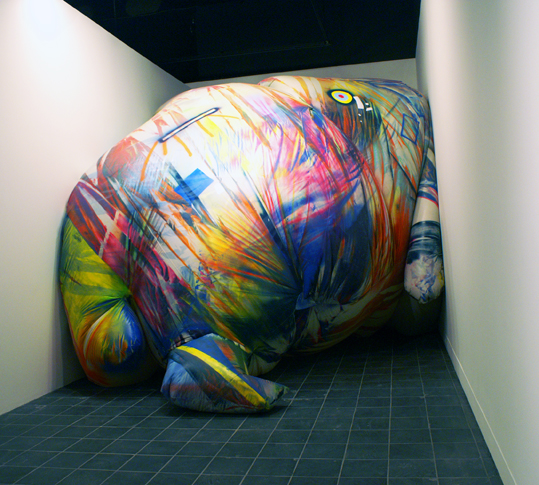
Claire Ashley, Installation shot from the group exhibition “My Crippled Friend” 2013, at Columbus College of Art and Design, Columbus, OH, spray paint on PVC coated canvas tarpaulin and fan, approx. 18’x18’x12’. Photo courtesy of the artist.
In conversation and researching your work, there is a reference to low-brow, mundane, and unconventional materials. Can you elaborate on your selection process and why this is a timely choice in medium selection?
Well practically speaking I use these materials because they are cheaper than traditional fine art materials, and when you work at the scale I do, you really have to take cost into consideration. On another level, I use readily available materials because I want the philosophical underpinnings of my work (democratic access) to be embodied by the material itself. So using PVC coated canvas tarpaulin (the material house painters use to protect floors), Rust-Oleum spray paint, duct tape, kids backpacks, and personal blower fans, becomes one way to do that. My husband says I need to buy shares in Menards and Home Depot 
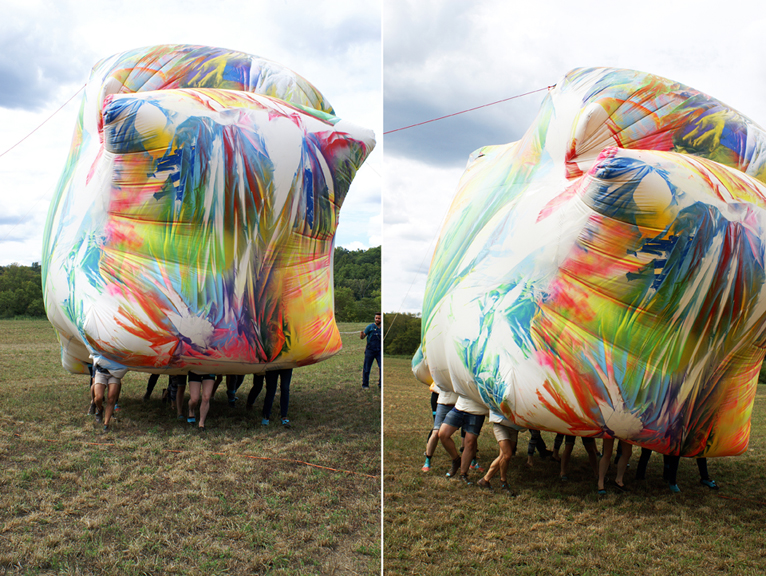
Claire Ashley, Documentation of performance “Ruddy Udder Dance” 2012, in collaboration with The Happy Collaborationists and ten resident artists at ACRE, Steuben, WI. Spray paint on PVC coated canvas tarpaulin and fan. Photo courtesy of the artist.
You have taught for some time at SAIC. Does your teaching practice have any impact on your artistic research and practice?
Most definitely! I find teaching to be a very creative endeavor, and as much about asking questions as it is about giving answers. I love problem solving with students around a topic, idea, medium, material, or context. I think curiosity, inventiveness, nimble thinking and problem solving are essential characteristics to both being a good teacher and being an interesting artist. This breadth of invention and thinking every time I’m in the classroom seeps into my thinking when I’m in my own studio. The possibilities for my own work have opened up over the years because of the variety of skills, materials, topics, and resources we introduce in Contemporary Practice classes at SAIC. Also my collaborative practice was born out of co-teaching with Mark Jeffery. His invitation to create a piece for a performance project led me into a new line of inquiry about sculpture as performative prop.
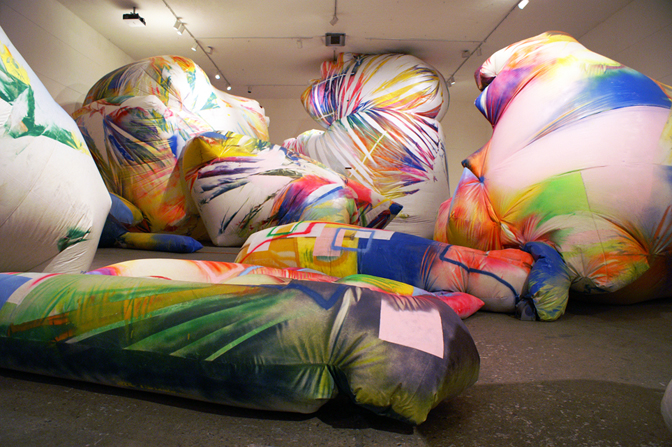
Claire Ashley, Installation shot from the solo exhibition “distant landscapes: peepdyedcrevicehotpinkridge” 2013, at ICEBOX project space, Crane Arts, Philadelphia, PA, Spray paint on PVC coated canvas tarpaulin and fans, installation filled space: 50’x100’x30’. Photo courtesy of the artist.
What type of preparatory work do you do prior to fabricating your sculptures and videos? Do all of these exists on the same plane or do place value on one or the other?
I make a lot of drawings and sketches of possible silhouette shapes that might become sculptural objects. I don’t make models or macquettes but usually go straight to the full-scale object. I value each part of my process immensely for different reasons. There are four parts in my mind – drawing, constructing, painting, and performing/installing/siting:
a. The thinking through drawing period is less physically taxing and more peaceful in some sense. It is a place for a combination of intuitive shapes and mark making to occur, for observed fragments of things (not usually the whole thing) from my surroundings to be made, for cultural source material to be appropriated, and quirky pairings of shapes to be invented. This discovery process, with a simple pencil and paper, is the bedrock of the work.
b. Constructing the form itself is an incredibly laborious, physically challenging, and often mind-bending task to ‘see’/ imagine how the pattern pieces will come together into the final form. The sewing happens on the concrete studio floor because the material is relatively heavy so it’s literally back breaking work. I sew the pieces in panels that become each side of the form (left, right, front, back, top, bottom). Each facing side is usually constructed to have a particular silhouette that matches, in order for their to be a symmetry of sorts (often interrupted) in how the piece comes together as a volume. However, the image I have in my head is not a static thing, and the process of construction is constantly being tweaked – sections are gathered, folds are added, limbs or extensions are grafted on, etc. I need the invention to continue happening as I sew the form together so the adding of pieces, the subtracting of others, the extensions that get inserted become a really important continuation of the play that is implicit in the work and it keeps things surprising. These forms are never quite known to me until the last seam has been sealed and the fan turns on. I should say, that sometimes I am not totally enamored with the forms essential shape, but I know that in the next step of the process that can be wrestled with using paint.
c. Once construction is complete, the painting and color invention on the surface begins. This happens over a number of layers and over the course of a number of days, to let each layer dry. Each pass of paint is a relatively quick process, but a deadly one. I wear a full respirator mask and enclosed goggles. Sometimes the form is gathered flat on the studio floor and painted while deflated, and at other times the piece is inflated in my yard and painted using stencils, and ladders to reach high enough. I also often turn the fan on/off to inflate/deflate the form while painting. This increases the number of folds the spray paint picks up to complicate the surface of the form, and camouflage its shape ostensibly. The painting allows me to pull sections of the form out into the foreground of the visual encounter and push other areas back to recede into the background of the encounter. The shape can change immensely just because of the location and intensity of the painting on it. In this way I’m often able to resurrect a form that I am not particularly persuaded by and surprise myself in the creation of each new work.
d. Now we have a painted form – a being, if you will. The final part of my process is to decide how these forms enter the world. Is it through humorous eruption into song and dance, or obnoxious scale relative to site, or squeezing, stacking, piling into space? This contextual component of the work is a moving target depending on the parameters of the exhibition or event. The forms I make do not need to be installed the same way each time they are shown, but some do exist as relatively static objects (even though they quiver with air) while others exist as wearable sculptures for the body, and often they can be interchangeable. I must make the decision during the construction process as to whether they are wearable or not as it changes the way they are made. If the form is to be worn then I must make entry points for the body to fit.
In looking at and experiencing your work there appears to be an ephemeral space between abstraction and forms that almost seem recognizable. Can you discuss your interest in abstraction and how recognizable objects surface in your sculpture and elsewhere?
Correct yes! As I mentioned in the first paragraph, I hope to create a sense of the uncanny within the sculptural forms I create, such that they are recognizable as cartoonish, animalistic, and somehow figural. That the extrusions have some body-like reference but that it’s hard to pin down exactly what that explicit reference is. They can be understood as abstract and figural at the same time and I hope that they are also child-like and raunchy at the same time too. I do not want to give people answers but to intrigue them into asking questions.
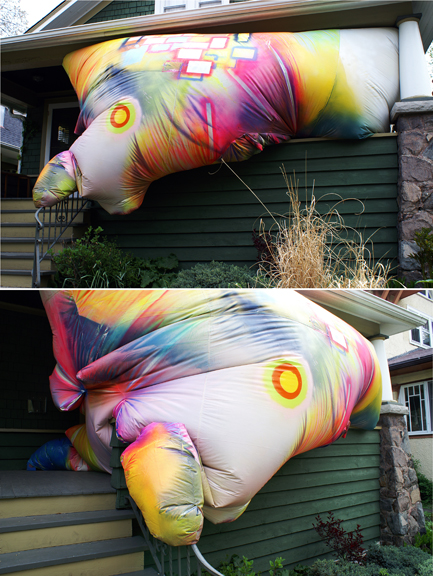
Claire Ashley, Installation shot from the site specific installation “limes and bricks suck pink you tasteless hunk” 2012, at TERRAIN: an exterior exhibition space, Oak Park, IL, spray paint on PVC coated canvas tarpaulin and fan, approx. 16’x10’x10’. Photo courtesy of the artist.
What are you working upon now?
Right now I’m cleaning and repairing a number of pieces that were installed outdoors this summer and got tagged and a little beat up. Luckily my philosophy allows me to fold this kind of intervention into the history of the piece such that I can clean, patch, and repaint it where needed to be resurrected again later.
Then I’m working on a lot of shows for the spring:
“Painting in Time”, Tetley Gallery, Leeds, England, UK, March – May, 2015; “Death by Committee”, Sam Coronado Gallery, Emma S. Barrientos Mexican American Cultural Arts Center, Austin, Texas, April 18 – June 13, 2015; “BLOW UP: Inflatable Contemporary Art”, Bedford Gallery at the Lesher Center for the Arts, Walnut Creek, CA, April 26 – June 21, 2015, extending into a two year travelling show. I’ve also just been invited to do an interactive performance piece for The Winter Festival in Milwaukee, WI on February 7 and I have a show with each of the galleries I’m represented by too. Not to mention that I will be teaching three classes in the spring at SAIC, continuing as one of four part-time faculty representatives at SAIC and being a wife, mom, house cleaner, and animal caretaker! Busy, busy
Claire Ashley lives and works in Oak Park, Illinois. Ashley’s work has been exhibited widely throughout the United States, including ICEBOX Gallery: Crane Arts, Philadelphia, PA; Chicago Cultural Center, Chicago, IL; Bahamas Biennale, Milwaukee, WI; Plush Gallery, Dallas TX; DeCordova Sculpture Park, Lincoln, MA; Arizona State University Museum, Phoenix, AZ; and other venues.
To view additional work by Claire Ashley, please visit:
http://www.claireashley.com/
http://claireashley.tumblr.com
https://vimeo.com/user6799460
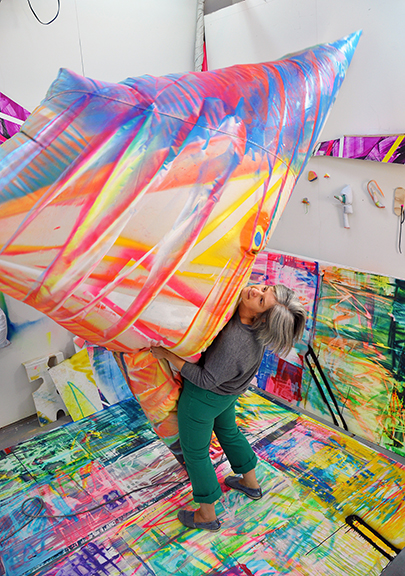
Claire Ashley, sculptor, Oak Park, IL, 2014
Interview and portrait by Chester Alamo-Costello


